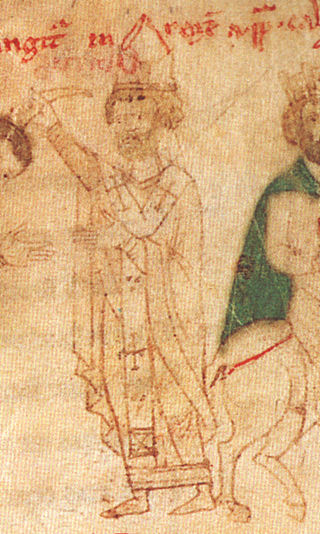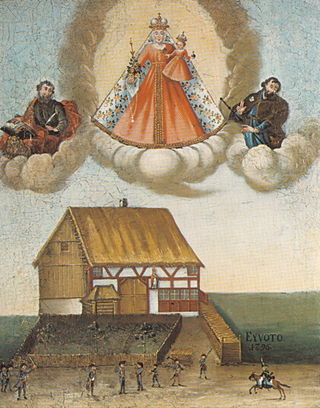Related Research Articles

Ambrose of Milan, venerated as Saint Ambrose, was a theologian and statesman who served as Bishop of Milan from 374 to 397. He expressed himself prominently as a public figure, fiercely promoting Roman Christianity against Arianism and paganism. He left a substantial collection of writings, of which the best known include the ethical commentary De officiis ministrorum (377–391), and the exegetical Exameron (386–390). His preachings, his actions and his literary works, in addition to his innovative musical hymnography, made him one of the most influential ecclesiastical figures of the 4th century.

The First Council of Constantinople was a council of Christian bishops convened in Constantinople in AD 381 by the Roman Emperor Theodosius I. This second ecumenical council, an effort to attain consensus in the church through an assembly representing all of Christendom, except for the Western Church, confirmed the Nicene Creed, expanding the doctrine thereof to produce the Niceno-Constantinopolitan Creed, and dealt with sundry other matters. It met from May to July 381 in the Church of Hagia Irene and was affirmed as ecumenical in 451 at the Council of Chalcedon.

Pope Boniface I was the bishop of Rome from 28 December 418 to his death on 4 September 422. His election was disputed by the supporters of Eulalius until the dispute was settled by Emperor Honorius. Boniface was active in maintaining church discipline, and he restored certain privileges to the metropolitical sees of Narbonne and Vienne, exempting them from any subjection to the primacy of Arles. He was a contemporary of Augustine of Hippo, who dedicated to him some of his works.

Pope Callixtus II or Callistus II, born Guy of Burgundy, was head of the Catholic Church and ruler of the Papal States from 1 February 1119 to his death in 1124. His pontificate was shaped by the Investiture Controversy, which he was able to settle through the Concordat of Worms in 1122.

Pope Siricius was the bishop of Rome from December 384 to his death. In response to inquiries from Bishop Himerius of Tarragona, Siricius issued the Directa decretal, containing decrees of baptism, church discipline and other matters. His are the oldest completely preserved papal decretals. He is sometimes said to have been the first bishop of Rome to call himself pope.
Pope Sixtus III was the bishop of Rome from 31 July 432 to his death on 18 August 440. His ascension to the papacy is associated with a period of increased construction in the city of Rome. His feast day is celebrated by Catholics on 28 March.

Pope Julius I was the bishop of Rome from 6 February 337 to his death on 12 April 352. He is notable for asserting the authority of the pope over the Arian Eastern bishops, as well as setting December 25 as the official birthdate of Jesus.
Pope Eugene II was the bishop of Rome and ruler of the Papal States from 6 June 824 to his death. A native of Rome, he was chosen by nobles to succeed Paschal I as pope despite the clergy and the people favoring Zinzinnus. The influence of the Carolingian Franks on the selection of popes was then firmly established. Pope Eugene convened a council at Rome in 826 to condemn simony and suspend untrained clergy. It was decreed that schools were to be established at cathedral churches and other places to give instruction in sacred and secular literature. His involvement in the Byzantine Iconoclasm controversy was largely inconsequential.

Intercession or intercessory prayer is the act of praying to a deity on behalf of others, or asking a saint in heaven to pray on behalf of oneself or for others.
Salamanes Hermias Sozomenos, also known as Sozomen, was a Roman lawyer and historian of the Christian Church.

Eusebius of Vercelli was a bishop from Sardinia and is counted a saint. Along with Athanasius, he affirmed the divinity of Jesus against Arianism.
The Patrologia Graeca is an edited collection of writings by the Church Fathers and various secular writers, in the Greek language. It consists of 161 volumes produced in 1857–1866 by J.P. Migne's Imprimerie Catholique, Paris.

Maruthas or Marutha of Martyropolis was a Syriac monk who became bishop of Maypherkat in Mesopotamia (Meiafarakin) for a period beginning before 399 up to around 410. He is believed to have died before 420. He is venerated as a saint in the Catholic, Greek Orthodox and Oriental Orthodox Churches, his feast being kept on 4 December.
Julian of Eclanum was bishop of Eclanum, near today's Benevento (Italy). He was a distinguished leader of the Pelagians of 5th century.
Ticonius, also spelled Tyconius or Tychonius, was a major theologian of 4th-century North African Latin Christianity. He was a Donatist writer whose conception of the City of God influenced St. Augustine of Hippo.
Anastasius I of Antioch was the Patriarch of Antioch twice.
Possidius was a friend of Augustine of Hippo who wrote a reliable biography and an indiculus or list of his works. He was bishop of Calama in the Roman province of Numidia.
Theodore Balsamon, also called Balsamo, was a canonist of the Eastern Orthodox Church and 12th-century Eastern Orthodox Patriarch of Antioch.
The Pneumatomachi, also known as Macedonians or Semi-Arians in Constantinople and the Tropici in Alexandria, were an anti-Nicene Creed sect which flourished in the regions adjacent to the Hellespont during the latter half of the fourth, and the beginning of the fifth centuries. They denied the godhood of the Holy Ghost, hence the Greek name Pneumatomachi or 'Combators against the Spirit'.

The Church Fathers, Early Church Fathers, Christian Fathers, or Fathers of the Church were ancient and influential Christian theologians and writers who established the intellectual and doctrinal foundations of Christianity. The historical period in which they worked became known as the Patristic Era and spans approximately from the late 1st to mid-8th centuries, flourishing in particular during the 4th and 5th centuries, when Christianity was in the process of establishing itself as the state church of the Roman Empire.
References
- ↑ Herbermann, Charles, ed. (1913). . Catholic Encyclopedia . New York: Robert Appleton Company.
- ↑ 344 (Mansi, "Collectio Amplissima Conciliorum", III
- ↑ Epp. cxxxiii and cxxxix, in Migne, P.L., XXXIII, 509, 535
- ↑ Ep. lii, in Migne, P.L., XXII, 527-40
- ↑ V, xiv; VII, xvii
- ↑ Epp. clii-cliii, in Migne, P.L., XXXIII, 652
- ↑ Bossuet, "Gallia Orthodoxa" pars I, lib. II, cap. v, in "Œuvres Complètes", XII (Bar-le-Duc, 1870), 98
- ↑ Codex Theodosii, app., cap. xiii
- ↑ Codex Justiniani", lib. I, tit. 4: "De episcopali audientia
- ↑ "Edicta Theoderici", cap. xiv (Mon. Germ. Leg., V
- ↑ KRAUS, Realencyklopädie der christlichen Altertümer, I (Freiburg im Br., 1882), 166-7
- ↑ RATZINGER, Gesch. der kirchlichen Armenpflege (Freiburg im Br., 1884) 133-9
- ↑ EALES in Dictionary of Christian Antiquities (London, 1876-80), s. v.
- ↑ LALEMAND, Histoire de la Charité, I (Paris, 1907-)
- ↑ Herbermann, Charles, ed. (1913). . Catholic Encyclopedia . New York: Robert Appleton Company.